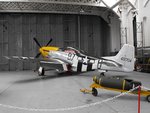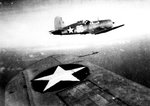Airframes
Benevolens Magister
I doubt that, when this P51 was given its nose art, a definite font was used, as the name would have been hand painted.
The colours were Olive Drab over natural metal, with the nose in Insignia Yellow. I haven't got a 3-view, but here's one picture i took of the Duxford based 'Frankie.
It may be that you can find further info from the 361st FG web site, and there are contact details there for the chaps who run the splendid new museum on the site of Bottisham airfield. What they don't know about the 361st is probably not worth knowing !
The colours were Olive Drab over natural metal, with the nose in Insignia Yellow. I haven't got a 3-view, but here's one picture i took of the Duxford based 'Frankie.
It may be that you can find further info from the 361st FG web site, and there are contact details there for the chaps who run the splendid new museum on the site of Bottisham airfield. What they don't know about the 361st is probably not worth knowing !



